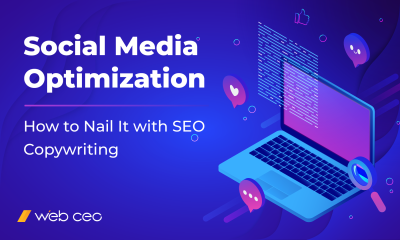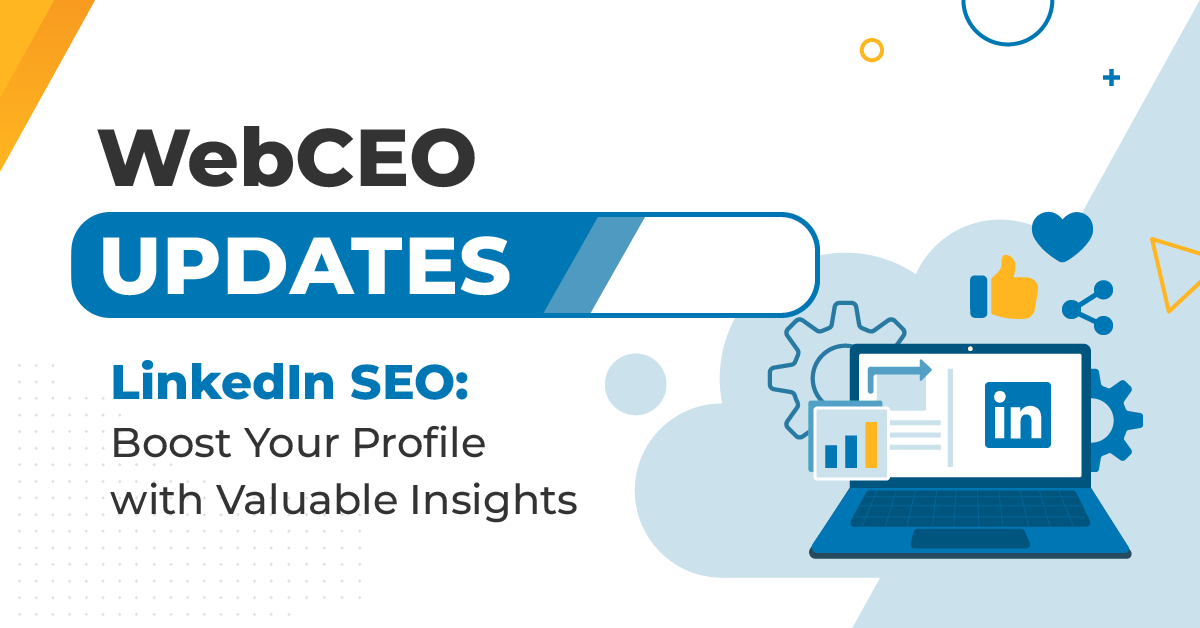
LinkedIn and SEO. Do they work together? Better than you’d expect!
Most of the time, people do SEO with Google in mind. Their goal is to make their website appear in Google’s top positions where the majority of users can find it. And while site owners often want their brands to be popular in social media as well, such a task requires its own approach – often unique to each social network. SMO and SEO are related, but they are two different beasts.
However, if you are an avid Google user, you might have come across an organic search result from the domain LinkedIn.com at least once. That’s right: Google indexes LinkedIn pages! And when Google indexes and ranks a page, then the rules of SEO apply.
Who needs LinkedIn SEO and why?
Unlike most other social media platforms, LinkedIn isn’t meant for entertainment. It’s a place for professionals to advertise their expertise and their brands. Whether you are a freelancer, an employee or a CEO, you can benefit both from using LinkedIn and optimizing your profile page.
What are the benefits?
- Reputation growth
- Forging connections
- New career opportunities
- Cultivation of your authority as an expert
- Interacting with your customers (and gaining new ones)
If you are serious about your future, then you can’t ignore LinkedIn.
And what about SEO for LinkedIn? It consists of three major elements:
- Your profile page information;
- Page activity (the content you post);
- Connecting with other professionals.
Time to go into detail about the whole process.
1. Find the right keywords
Keywords and keyword optimization haunt every website with a search feature. LinkedIn is no exception. It’s just a matter of knowing how to find good keywords and how to use them.
If you have a website and use LinkedIn to promote it, then you should already have a list of good keywords – the same ones you use on your site.
But better to be safe than sorry. Cover your bases by taking these steps:
- Research the topics that your target audience is interested in – then collect the most promising key terms and phrases from there.
- Prepare a list of terms relevant to your specialty. For example, if you are a C# programmer, then you will want to use words like senior developer, Visual Studio etc. in your profile and content.
How to find keywords for LinkedIn?
There are two great places to look. The first of them is LinkedIn itself.
- LinkedIn profiles. Users with complete profiles will often have a full list of their skills and qualifications. Not only it shows what they can do, it also helps them to be found by the right people. Be sure to adopt the same tactic!
- Search bar. Suppose you are looking for a .NET developer. If you type that in LinkedIn’s search bar, you will receive a bunch of similar search queries before you even press Enter. And after you do, the search results will also have more expanded descriptions like Entry level .NET developer or Senior full stack .NET developer.
The other place to look is an SEO tool for finding keywords, such as WebCEO’s Keyword Suggestions. Type in your keyword ideas and pick the results with the highest search volume – i.e. the ones most searched by users.
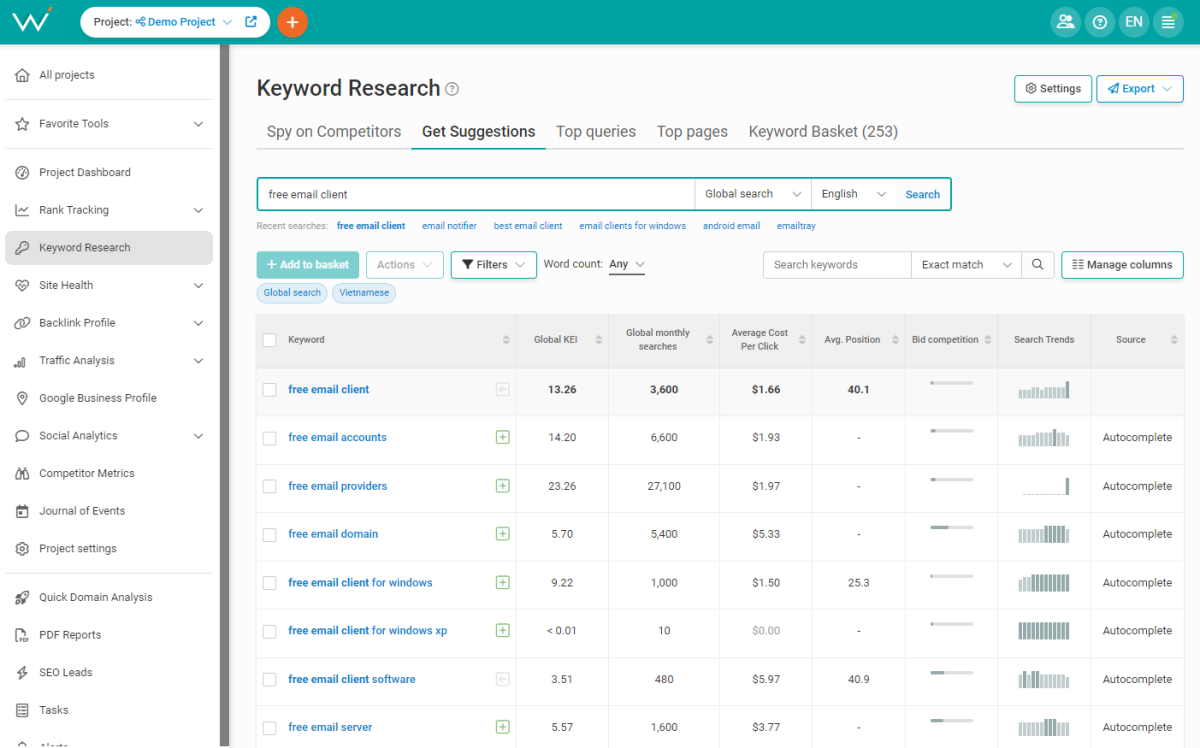
2. Use images in your profile
First impressions matter always, on LinkedIn as well.
Once people find your LinkedIn profile, it will take them only a few moments to decide whether you are worth their time. Make those moments count by uploading an avatar (or profile picture) and a banner (or hero image).
What kind of avatar do you need?
- For a personal page, it must be your headshot. Upload your best, most presentable-looking photo. Suiting up and smiling are optional; facing the camera is mandatory.
- For a company page, upload the logo.
The ideal dimensions are 400×400 pixels.
What kind of banner do you need?
The background banner is much larger than the profile picture. The recommended size is 1584×396 – wide enough to cover a good portion of any screen. Just imagine how much information you can put in all those pixels!
You may correctly assume that banners need text; just don’t overdo it. A tagline is good. A call-to-action is great. Stating the value you offer is the best. Be brief and get to the point, and your visitors will be impressed.

(Image source: Cultivated Culture)
Design a good banner with these things in mind, but be careful with its bottom left corner! Don’t put anything important there – that part will be covered by your avatar.
3. Fill out your information
After the imagery comes the text. Time to fill out your profile and put your keywords to good use.
There’s a lot of work to do and many ways to enhance your page’s SEO.
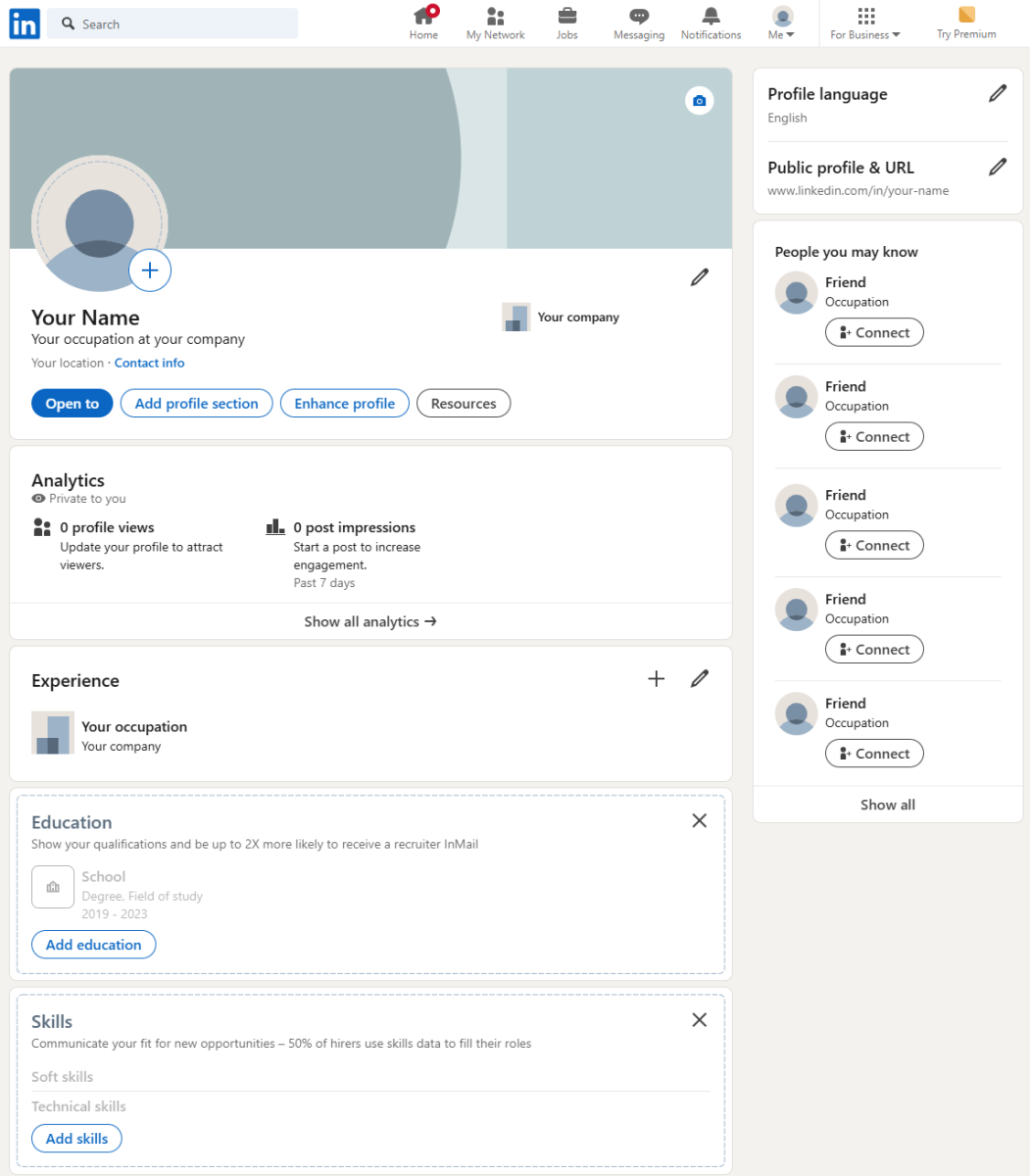
Start editing your profile page and fill out as many sections as you can! Complete profiles look better than incomplete ones on any day – leave no stone unturned.
The sections are divided between three groups:
- Core: the basic information about you. Full name, current position, services, education, skills and so on. This is the bare minimum you need to fill out – but do feel free to keep going.
- Recommended: if you have any certifications, licenses, courses or recommendations, this is the place to display them.
- Additional: if you are a real expert, you can show off your awards, patents or publications here. This group also includes sections for your contact information and the languages you speak, so make sure to add them.
As a rule of thumb, the greater a section’s character limit, the better it is for using keywords. For example, sections like Headline and About are where you describe what you do, making them perfect for adding a keyword or two.

What about the company pages on LinkedIn? In terms of filling out your profile, they work almost the same. They have just two more very important sections:
- Products: describe what you are selling, pricing plans, highlights, videos and screenshots.
- Jobs: your open positions.
LinkedIn appreciates every bit of relevant information you add. The more you can tell about yourself and your company, the more chances you have to catch the attention of the right people.
4. Publish high-quality, SEO-friendly content
Now that your profile page looks great and optimized, it’s time for the next step: page activity.
Just like every other platform, LinkedIn values original, high-quality content. Even better if it’s optimized to be picked up by search algorithms.
Since Google indexes LinkedIn pages, you can safely follow the same SEO methods you want to use for any other website:
- Make posts and publish articles. As always, they need to match the user search intent and offer value to users.
- Use eye-catching headlines. Make the viewers interested as soon as they see your post in their feed.
- Post often. At least a couple times a week will do, but if you can do it even more often – power to you.
- Create many different types of posts. Don’t restrict yourself to text posts. Diversify your LinkedIn content by posting images, videos and polls as well.
- Include keywords. Use them throughout your texts in a natural way, avoid stuffing and cannibalization (optimizing multiple pages for the same keywords). Titles, headings and image captions love keywords.
- Add call-to-actions. If you want visitors to not just read, but also do something beneficial to you after reading (like buy your product), this step is a must.
- Respond quickly! Engagement is a powerful ranking signal on LinkedIn. When users comment under your posts, be quick to reply and give them a reaction. That way, you will appear in their notifications and prompt them to interact with your page some more.
5. Create connections
Now you have an optimized LinkedIn profile page and high-quality content. All that’s left is to somehow bring visitors to your profile. But how?
No matter how well you optimize your content for search, it will never be enough on its own. This is where LinkedIn’s main weapon comes in: connecting with other people.
What can – and should – you do on LinkedIn?
- Follow other people and groups. When you follow someone, use the opportunity to introduce yourself and state your expectations. Just remember that on LinkedIn, being civil and professional is an absolute must. (Don’t take Inigo Montoya’s example too literally.)

- Comment under and react to other people’s content. The best comments are the ones where you add your 5 cents about something the original poster may have missed, or ask questions about that.
- Make your own posts in groups. Take the initiative and start discussions yourself – that will earn you a lot more attention.
- Answer questions. If someone pings you by mentioning your name, it’s your chance to demonstrate your expertise. The better your answer, the more likely you are to impress the right people.
Most of the time, your feed will be filled with content from the pages you follow, and the opposite is also true. More followers = more visibility.
Be active on LinkedIn, expand your bubble and e-meet as many professionals as you can. Doing so will open the path to the next major step in LinkedIn SEO…
6. Collect endorsements and recommendations
After you connect with someone and add them to your network, you unlock the option to endorse their skills and give them recommendations. Naturally, it works both ways: people in your network can do the same for you.

(Image source: Cultivated Culture)
It doesn’t get more straightforward than that. Other professionals in the field directly vouching for you – could you ask for a better boost to your reputation?
It’s obvious why LinkedIn sees this as a ranking signal. If there are people who can confirm that you are a pro, then you definitely deserve getting picked up by the search algorithm.
Just like with customer reviews, the best way to get endorsements and recommendations is to ask the people you’ve worked with.
7. Track and analyze relevant metrics
How do you know your LinkedIn SEO strategy is working?
If your profile is buzzing with notifications, if you are getting job offers or CVs day and night, then you’ve definitely succeeded. But that probably won’t happen as soon as you make your first comment somewhere.
It will be a slow, gradual process that you can monitor with special tools – and adjust your strategy based on your progress (or lack thereof).
LinkedIn Analytics display how users interact with your profile and how popular it is overall. Those metrics include:
- Number of your followers;
- How many people viewed your profile;
- How many times you appeared in other people’s search.
Analytics for company pages will have even more data:
- User engagement (likes, shares, comments);
- Clicks, impressions and CTR for your posts;
- Follower demographics (location, industry, seniority);
- Competitor metrics (followers, engagement).
What if you are managing multiple LinkedIn business pages? In this case, you should connect them all to WebCEO’s LinkedIn Insights tool – and you’ll be able to switch between their data in a single click.
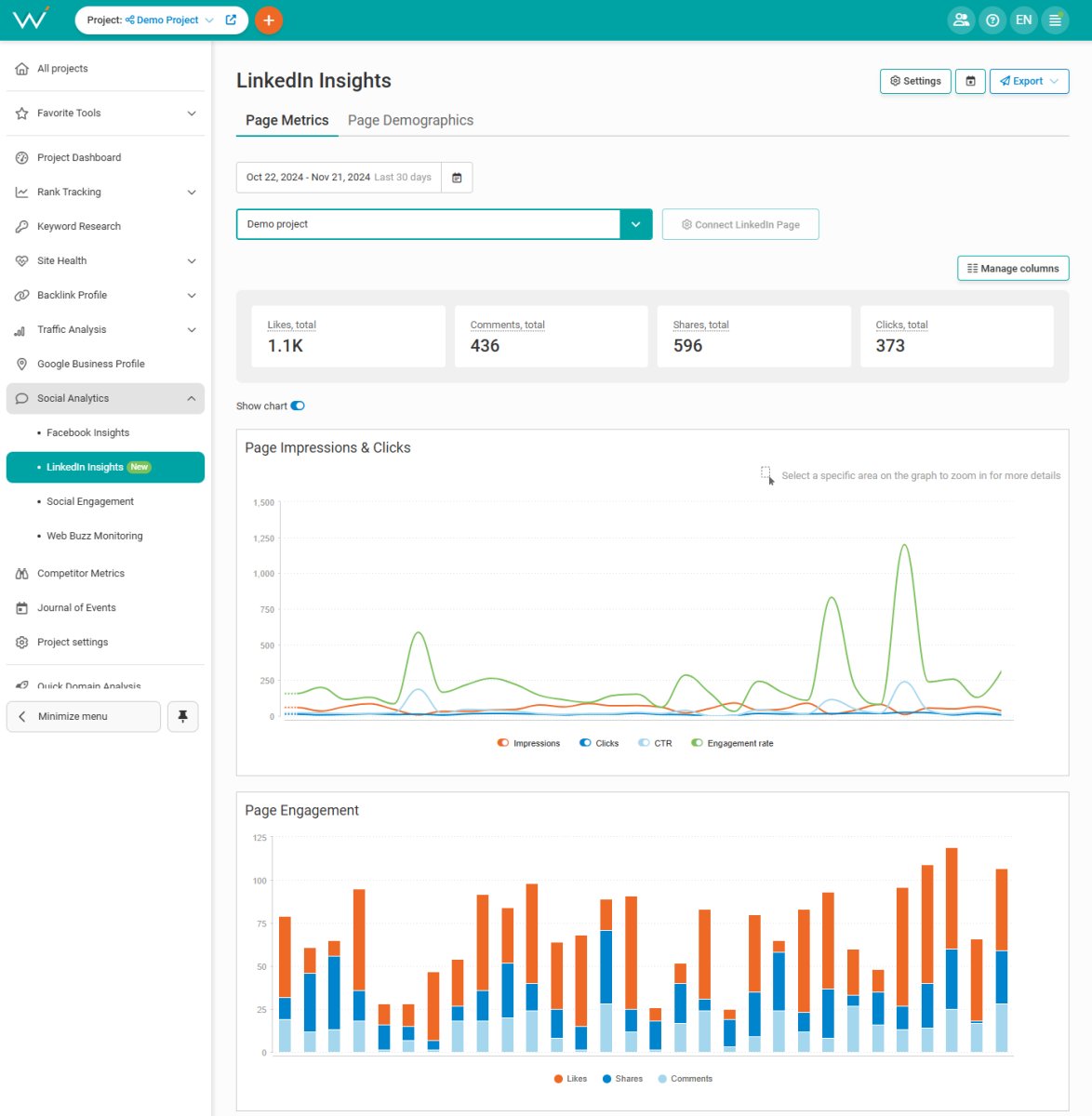
With all relevant data at your fingertips, you can plan the next step to make your LinkedIn SEO strategy succeed.
